Until 7th grade, my family lived in New England. I have the best memories of growing up in a little town called Boxborough, in Massachusetts.
The colonial history of the area in which I grew up has always fascinated me. Living not far from Concord and Lexington, we field-tripped to all the popular haunts from that historical era.
And of course, as an adult, I look back on the places there that I’ve never been to, but wish I had. Places like Plymouth Plantation. Never been! Martha’s Vineyard – never been! I always think that I’ll go back and see it all with the eyes of an adult – visiting the same places, experiencing new places, and testing whether or not the charm of the area where I grew up is as real to me now as it is in my memory.
When the Museum of Fine Arts in Boston published the book Women’s Work: Embroidery in Colonial Boston, it struck a chord with me. The title encompasses two things I love: my happy memories of the place I grew up and embroidery. So of course, I had to get the book!
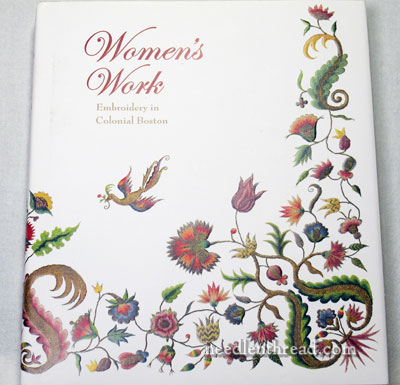
But it’s not just the subject matter that compelled me to buy the book. I know we’re not supposed to judge a book by its cover; still, I admit that the cover of this book was the final selling point for me. I think the cover is gorgeous!
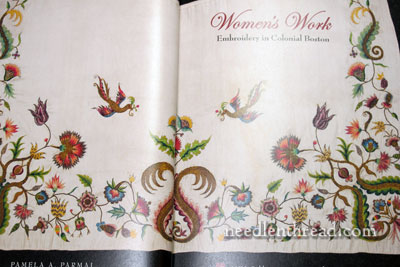
Women’s Work is a book that does more than just recount the history of needlework in New England. Highlighting pieces from the collections at the Museum of Fine Arts in Boston, the book tells the tale of six different women in colonial Boston and the role of needlework in their lives and, by extension, in the lives of women in New England from the colonial period. The book is a combination of biography, art studies, sociology, and history, with a smattering of science thrown in at the end. It’s fascinating to read!
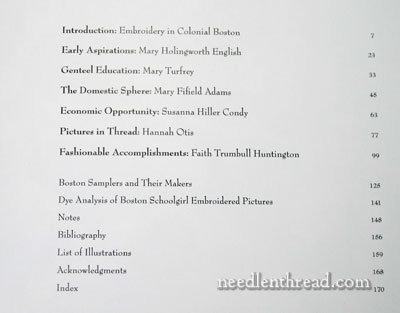
The bulk of the book focuses on six and their relationship with needle and thread. Reading about these Bostonians is a good reminder of the important and formative role needlework has played in the lives not only of women throughout history, but of all of our society – how needlework influenced trade and affected social and economic climates. Needlework, you know, is powerful stuff!
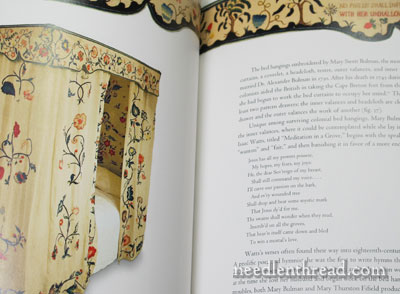
The book is predominantly a scholarly book more than anything else. It is loaded with good research and historical information, but it reads gently, like a story.
In addition to the quality writing and research – and this important, because it is, after all, a book about embroidery – the book is jam-packed with beautiful photos of embroidery from the eras discussed.
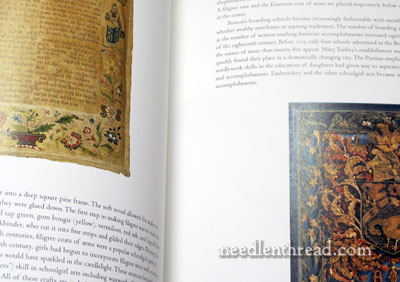
If the book were made up just of text, I’d still find it interesting, but it would not be as enjoyable. The luscious photos throughout compel the reader to go deeper and deeper into the book!
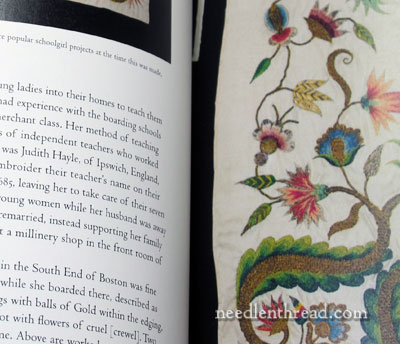
If you have a love of historical embroidery, if you are mesmerized by samplers of old and embroidered household goods, clothing, and the like from eras past, you will love this book! No, it’s not a technique book. Instead, it’s a book that will give you a deeper appreciation for the art you already love – the art of embroidery.
Where to Find It
You can find Women’s Work: Embroidery in Colonial Boston through the following book affiliates:
In the US, Women’s Work is available here, through Amazon.
Worldwide with free shipping, it’s available here, through Book Depository.







Books like these are so lovely, and great to have on the bookshelf when looking for ideas and inspiration. Thankyou for bringing our attention to this book.
Mary, I have this book too and the cover is certainly gorgeous. It is a wonderfully interesting read. I love to look at old samplers and historical embroideries, but more so, I am curious about the girls and women who stitched them.
I purchased the book directly from the museum as I was on a list to be notified when the book was finally published.
Nice to read about good memories and even see them connected with embroidery… Sentimental values are so important 🙂 thanks for sharing, Mary
Thank you SO much for letting us know about this book! I grew up in the Midwest and moved to Massachusetts in 1984. I’ve worked at historic houses and a quilt museum so this book is a must-have for me. Keep spreading the word!
Dear Mary
Thanks for the review, I love reading about people’s lives and their history and how the history of embroidery affected society both economically and socially, it sounds really interesting.
Regards Anita Simmance
How timely! I was musing on the importance of needlework and the possible financial freedom it offered women of days past just this weekend. I will need to get this book for sure.
Doreen from Maine
this is a beautiful book. thx for sharing
This book was based on an exhibit and I was fortunate enough to see the works in person. The book truly does the art justice and I highly recommend it.
I saw some of those embroideries last year at t he MFA ( my husband lives in MA) but we didn’t see the book. I bought it online first thing this morning.
There is another beautiful book on New England embroidery called “Connecticut Needlework women art and Family 1749 -1840” published by the Connecticut Historical Society, but it is more of a catalog.
It looks like a wonderful book. My cousin lived in Boxborough for almost 30 years and raised her children there. We visited Concord, Lexington, and many of the other historical sites in MA when my daughter was at Wellesley. I think when you go back you will be just as delighted as when you were a child.
G’day Mary,
I love the thought that the book ‘reads gently, like a story’. That’s beautiful, motivating friendly thoughts.
‘Women’s Work’. I’ve never forgotten the annoyance I felt when visiting a farming family years ago. The dad scoffed at his young son for “doing women’s work” when he was cross stitching with his mum and myself.
I’m sure he wouldn’t have discouraged his daughter (if he had one) from horse riding or fishing for a hobby!
Very special book. Enjoyed looking into it.
Cheers, Kath.
I wish they had had the book available at the MFA last spring when my daughter and I visited the exhibit! I even looked for one in their shop! Thanks for the review. I will have to order the book and then go find my digital pictures. I was rather disappointed in that I thought the exhibit was rather small.